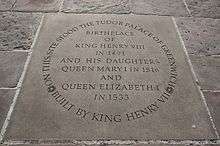Palace of Placentia

The Palace of Placentia was an English Royal Palace built by Humphrey, Duke of Gloucester, in 1443,[1][2] in Greenwich, on the banks of the River Thames, downstream from London. It was demolished by Charles II in 1660, to make way for a new palace. Nearly 40 years later, the Greenwich Hospital (now the Old Royal Naval College) was built on the spot instead.
History
Humphrey was regent during the rule of Henry VI and built the palace, in 1433,[2] under the name Bella Court.[3] In 1447, Humphrey fell out of favour with the new queen, Margaret of Anjou, and was arrested for high treason. He died in prison (William Shakespeare says he was murdered) and Margaret took over Bella Court, renaming it the Palace of Placentia, sometimes written as the Palace of Pleasaunce.[3]

Henry VII rebuilt the palace, with a design based around three large courtyards, between 1498 and 1504.[3]
It remained the principal royal palace for the next two centuries. It was the birthplace of King Henry VIII in 1491 and figured heavily in his life.[4] Following the king's marriage to Catherine of Aragon, Placentia became the birthplace of Mary I in February 1516.[5] After Henry VIII's marriage to Anne Boleyn, his daughter, later Queen Elizabeth I, was born at Placentia in 1533,[6] and he married Anne of Cleves there in 1540. A tree in Greenwich Park is known as "Queen Elizabeth's Oak", in which she is reputed to have played as a child.[7]
Both Mary and Elizabeth lived at Placentia for some years during the sixteenth century, but during the reigns of James I and Charles I, the Queen's House was erected to the south of the Palace.[8] Placentia fell into disrepair during the English Civil War, serving time as a biscuit factory and a prisoner-of-war camp.[8][9] In 1660, Charles II decided to rebuild the palace, engaging John Webb as the architect for a new King's House.[10] The only section of the Palace to be completed was the east range of the present King Charles Court, but this was never occupied as a royal residence.[10] Most of the rest of the palace was demolished, and the site remained empty until construction of the Greenwich Hospital began in 1694.[10]
Modern era
The Greenwich Hospital complex became the Greenwich Royal Naval College in 1873, when the naval college was moved from Portsmouth.[11] The buildings are today occupied by the University of Greenwich and the Music Faculty of Trinity Laban Conservatoire of Music and Dance.[9][12]
Construction work for drains in late 2005 identified previously unknown Tudor remains. A full archaeological excavation completed in January 2006 found the Tudor Chapel and Vestry with its tiled floor in situ.[13] The vestry of the old Palace was not demolished and later became the home of the Treasurer of Greenwich Hospital.[14]
References
- ↑ John Bold. Greenwich: An Architectural History of the Royal Hospital for Seamen and the Queen's House. Paul Mellon Centre for Studies in British Art in association with English Heritage. p. 7. ISBN 978-0-300-08397-2.
- 1 2 John Richardson (2000). The Annals of London: A Year-by-year Record of a Thousand Years of History. University of California Press. p. 64. ISBN 978-0-520-22795-8.
- 1 2 3 Alison Weir (September 2008). Henry VIII: King and Court. Vintage. p. 10. ISBN 978-0-09-953242-2.
- ↑ James Panton (24 February 2011). Historical Dictionary of the British Monarchy. Scarecrow Press. p. 247. ISBN 978-0-8108-7497-8.
- ↑ James Panton (24 February 2011). Historical Dictionary of the British Monarchy. Scarecrow Press. p. 326. ISBN 978-0-8108-7497-8.
- ↑ James Panton (24 February 2011). Historical Dictionary of the British Monarchy. Scarecrow Press. p. 178. ISBN 978-0-8108-7497-8.
- ↑ Time Out Guides Ltd (7 February 2012). 1000 things to do in London for under £10. Ebury Publishing. p. 215. ISBN 978-1-4090-8520-1.
- 1 2 Michelin; Michelin Travel &. Lifestyle (1 March 2012). London Green Guide Michelin 2012-2013. MICHELIN. p. 410. ISBN 978-2-06-718238-7.
- 1 2 Lewis Foreman; Susan Foreman (2005). London: A Musical Gazetteer. Yale University Press. p. 178. ISBN 978-0-300-10402-8.
- 1 2 3 Trudy Ring; Noelle Watson; Paul Schellinger (28 October 2013). Northern Europe: International Dictionary of Historic Places. Routledge. pp. 432–434. ISBN 978-1-136-63944-9.
- ↑ Mike Osborne (30 November 2011). Defending London: A Military History from Conquest to Cold War. History Press Limited. p. 158. ISBN 978-0-7524-7931-6.
- ↑ The Guardian (1 July 2010). The Guardian University 2011. Random House. p. 378. ISBN 978-0-85265-216-9.
- ↑ Ravilious, Kate (2006-02-09). "Henry VIII's Lost Chapel Discovered Under Parking Lot". National Geographic. Retrieved 2014-08-11.
- ↑ "Major Archaeological Discovery at Greenwich: Henry VII’s Chapel & Vestry". Old Royal Naval College Greenwich. 2006-01-24. Retrieved 2014-08-18.
Further reading
- Jennings, Charles (2001). Greenwich: The Place Where Days Begin and End. London: Abacus. ISBN 0-349-11230-4.
External links
| Wikimedia Commons has media related to Palace of Placentia. |
- "Early history". Old Royal Naval College.
- "Tudor Chapel". Inside Out. London: BBC. February 17, 2006.
Coordinates: 51°28′56″N 0°00′24″W / 51.48222°N 0.00667°W

.svg.png)